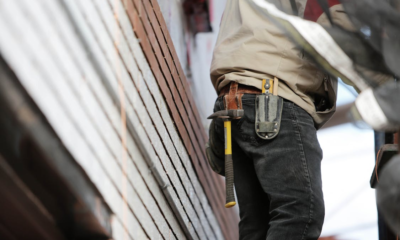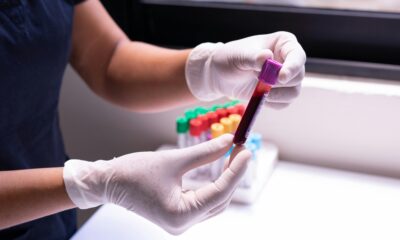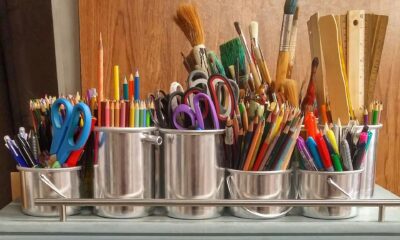Lifestyle
Step-by-Step Guide: Creating a Custom Beanie From Hat Design
Published
11 months agoon

Are you tired of searching store after store for the perfect beanie that matches your style? Look no further! Today’s blog post offers a step-by-step guide on how to create your very own custom beanie from start to finish – whether you are an amateur DIY enthusiast or experienced crafter, this tutorial will guide you from designing your unique hat pattern all the way through personal touches that showcase your unique individuality! Get ready to unleash your creativity while staying warm while we embark together on this thrilling journey!
Introduction to Custom Beanie Design
How to make custom beanies? In this guide we’ll walk through how to design and stitch your one-of-a-kind beanie.
Before beginning, you’ll need a few supplies. For the beanie itself, you will require 1 skein of worsted weight yarn in a color of your choosing and 5 US size 8 (5 mm) double-pointed needles; additionally you will require a tapestry needle, scissors and tape measure.
Once you have all of your supplies ready to go, it’s time to begin designing! First take measurements of the head circumference of the person who will wear the beanie. For an accurate reading, have them wear their hair in its normal style while wearing a beanie; use a tape measure and measure from just above their ears around to the widest part of their head before returning back again as this will provide your head circumference measurement.
Next, determine the height of the beanie. A good rule of thumb would be to make it one inch shorter than your head circumference measurement; so, for instance, if it were 21 inches you’d want a beanie 1 inch shorter.
Materials Needed for Custom Beanie Production
If you want to create your own custom beanie, here is a list of materials and a brief description for each:
-Fabric: When designing a beanie, fabric selection will be key. There are various varieties to consider so take time deciding which will work best with your design.
Once you’ve selected fabric for your beanie, the next step will be choosing thread that matches. This thread will serve to sew together the fabric.
-A sewing needle is essential in stitching fabric together. Make sure it is sharp and fits the type of fabric being used.
-Scissors: Scissors will be needed for cutting fabric pieces for your beanie. Find a pair that are sharp enough to handle different fabrics easily.
Pins: Pins can help keep your fabric secure as you sew, as well as help when cutting fabric pieces out. Be sure to get different sizes of pins so you can use them on various fabrics.
How to Design Your Own Beanie
Beanies are always fashionable when it comes to headwear, as they provide warmth in winter while making a fashion statement. If you want a unique beanie that no one else has, why not design one yourself? With just a few steps and your imagination, creating custom beanies that combine style with personalization could not be simpler!
Start by gathering supplies. Gather fabric, scissors, thread, needle and measuring tape as part of your toolset. Measure your head using the measuring tape – wrap it snugly but not too tightly around your head above your ears – ensuring a snug but not tight fit between ears; write down this measurement so you can refer back later if necessary.
Next, cut a piece of fabric twice the length and width of your head measurement and 12 inches wide. Fold in half lengthwise and sew along one long side using either a sewing machine or needle and thread to join them together along one length side. After sewing is complete, turn out right side out so the seam is on the inside of the tube of fabric.
Now it’s time to shape your beanie! First, fold down one end by 2 inches and sew along it – this will become the brim. Next, try on your beanie and mark where it sits comfortably on your head using a pen or pencil – that way when finished you know which part sits where.These are all good beanie design ideas.
Prepping Your Hat For Sewing
Once your design is in place, the next step should be preparing it for sewing. If using a store-bought pattern, follow its instructions on the back; if customizing an existing one with your own designs, use washable markers to trace out your pattern onto paper or directly onto fabric.
Once your pattern pieces are cut out, it’s time to start cutting! Use sharp scissors and make sure that all cuts along the lines are precise as possible for optimal results. Once all your pieces are cut out, it’s time to start sewing!
Sewing Your Hat Once your design is finished, it’s time to sew! This step-by-step guide will show you how to craft an original beanie based on your own idea.
1. Cut two circular pieces of fabric using your hat template. Make sure that one of them is slightly bigger than its target so you can sew it together easily.
2. Place both pieces of fabric right sides together with wrong sides facing in. Sew around all four edges, leaving an opening at the top for turning right-side-out.
3. Flip your hat right side out through its opening at the top. Use a chopstick or similar object to help push out its corners so they are even and sharp.
4. Close the opening by sewing with either a hidden stitch or ladder stitch – hand sewing this is also possible if preferred.
5. Enjoy Your Custom Beanie
Finishing Touches and Adding Embellishments
Your hat is nearly finished! Now it’s time to add those final touches and embellishments that complete its appearance.
If you are using a store-bought beanie as your base, attach any patches with fabric glue. If crocheting your own beanie instead, embroider or crochet your desired designs directly on to it!
Once your embellishments have been added, give the beanie one last once-over to make sure everything is secure – now you have an eye-catching custom-made beanie!
Custom Beanie Care and Maintenance Tips
Your custom beanie is an investment and with proper care will last for many years. Here are some tips on how to care for it:
As needed, spot clean the areas to be maintained with a damp cloth.
-Do not machine wash or dry clean this garment.
Restructure and lay flat to dry.
Store in a cool, dry location when not in use.
Conclusion
Crafting your own custom beanie is an exciting and creative way to express yourself! By gathering materials, tools, and instructions necessary, it can easily create an original design that stands out from the crowd. Once you understand all that goes into designing and crafting a beanie for yourself – all it’s left to do is choose colors and fabric that reflect who you are! Get crafting now; don’t hold back from making an impactful fashion statement with your fashion choices!
Recent News


4 Amazing Trips for Your Family
Choosing somewhere for a family vacation that would pique the attention of adults and kids alike can be a fun...


Customising Your Makeup with Blendable Blush Options
In cosmetics, one’s face is a canvas for self-expression and creativity. Among the myriad of products available, blush is a...


The Benefits of Regular Home Maintenance
Regular home maintenance is essential for maintaining and even raising the value of your house. A proactive approach to repairs...


Understanding the Importance of SEO in Adelaide
In the digital marketplace, Adelaide businesses are in a continuous contest to gain the attention of their target audiences. With...


Breaking Down the Numbers: Understanding the Average Traveling Nurses Pay
The open road, adventure, and the chance to heal – travel nursing promises an undeniable allure. But amidst the excitement,...


Dealing with Oily Skin in Summer: Tips and Tricks
As the temperature rises, those with oily skin often face an additional challenge—maintaining a clear and balanced complexion. Excess oil...


Mountain Wedding Ideas for 2024
A mountain wedding is a stunning choice for couples who cherish nature and desire a distinctive wedding experience. Whether you...


3 Of The Best Ways To Keep Your Salon Clean
It is of the utmost importance to ensure that a salon is kept scrupulously clean, not just for the sake...


3 Reasons You Should Get Blood Tests Every Year
Regular blood tests are essential for preserving general health and identifying potential problems early on. Medical professionals can evaluate your...


How to Make Your Next Crafts Project Pop
Crafting is a creative outlet that allows individuals to express themselves through various mediums such as paper crafts, sewing, painting,...
